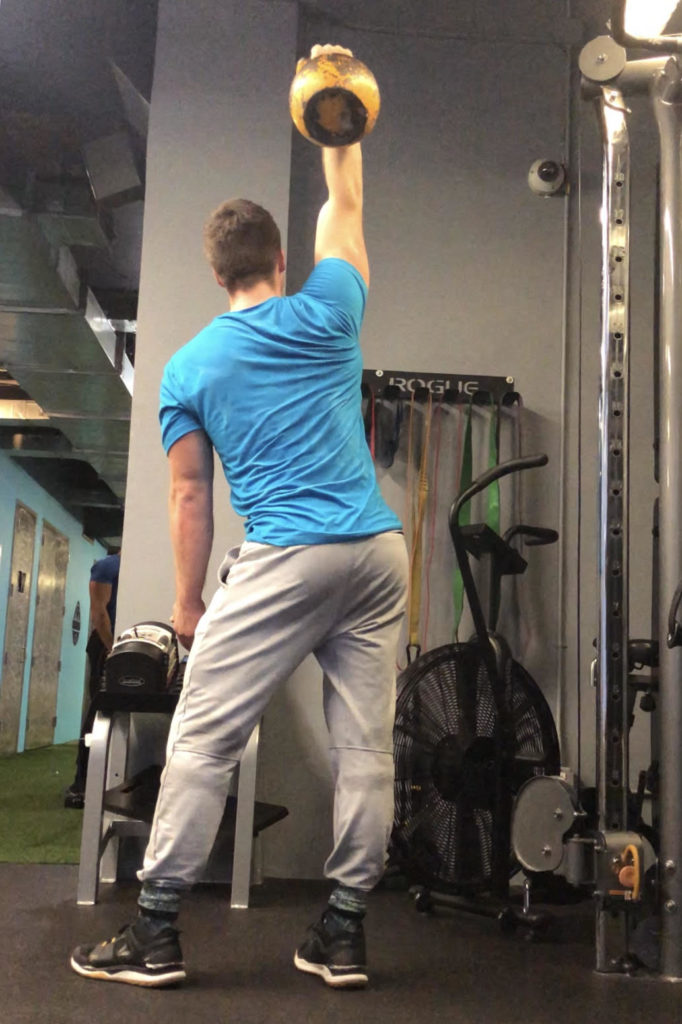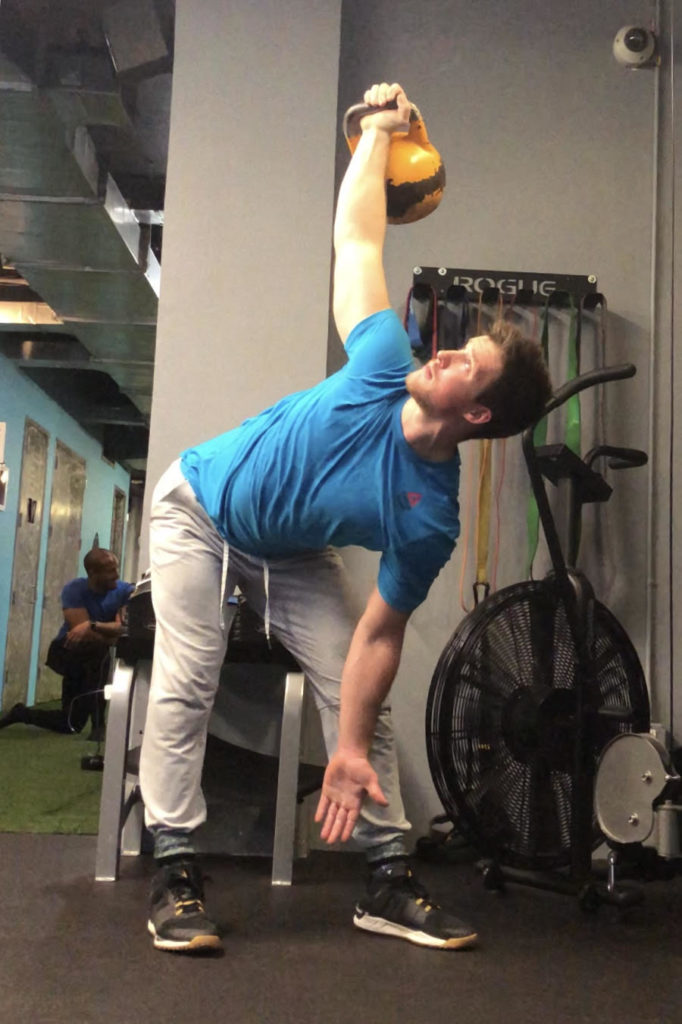Movements like the kettlebell windmill offer coaches and athletes both stability and mobility training benefits across most joints and tissues of the human body. Strength, power, and finess athletes can utilize the kettlebell windmill to improve hip mobility, increase shoulder strength and stabilization, and build out non-sagittal plane movement patterns.
In this kettlebell windmill exercise guide, we will cover:
- Kettlebell Windmill Form and Technique
- Benefits of the Kettlebell Windmill
- Muscles Worked by the Kettlebell Windmill
- Kettlebell Windmill Sets, Reps, and Programming Recommendations
- Kettlebell Windmill Variations and Alternatives
- and more…
How to Do the Kettlebell Windmill
Below is a step-by-step guide on how to properly set up and perform the kettlebell windmill.

Step 1: Start with you right foot directly underneath you hip and your left leg slightly angled out, with a load held in the right hand overhead.
As you can see in the photo, the toes should be turned to the left and the lifter placing weight into the right hip.

Step 2: Once in the start position, take you left hand and place it along the thigh, with the palm up.
It is important that you keep the back of the hand in contact with the left leg throughout the movement, as if the hand was a “train” and the leg was the “tracks”.

Step 3: When ready, slightly rotate your torso to towards the floor (left shoulder forward) and place load into your right hip as you descend.
If you have started this step with slight rotation and have kept the left hand on the left leg, you should feel a stretch in the right glute, hamstring, and side. Be sure to sit into the hip, placing your weight in those muscles. For best results, be sure to keep you right leg straight (no knee bend).

Step 4: At the bottom of the windmill, you should have your weight in the right hip, feeling a stretch in your right leg and hip, and stabilizing a load with you right hand.
Be sure to feel the stretch and control in the muscles.

Step 5: To assume the finished and upright position, contract the right glute and hip to extend the hips forwards as you slowly unwind your body (from the rotational process in step 3.)
Once again, be sure to keep the load locked out overhead and the left hand on the left leg as you come up.
Muscles Worked – Kettlebell Windmill
The below muscle groups are worked by the kettlebell windmill. Note, that this exercise also works the upper body, much like standard overhead holds do. That said, the below muscles groups are highly targeted and used to promote stability (core, triceps, and shoulder) and mobility (hips).
Shoulder Stabilizers
The kettlebell windmill demands high degrees of shoulder stability, mobility, and strength across most ranges of motion. The shoulder muscles and shoulder stabilizers (such as the rhomboids, rotator cuff muscles, and even upper back) are responsible for the isometric contractions that help to support the load overhead through this movement.
Obliques and Abdominals
The obliques and abdominals work to resist spinal flexion, extension, and lateral flexion under load, which can improve a lifter’s injury responds and core strength. Often, lifters will allow slight lateral flexion to occur in bent movements, however the windmill will reinforce proper hip hinging mechanics and movement to support spinal integrity in the windmill (via improved core stability/strength).
Glutes and Hamstrings
The glutes and hamstrings are targeted greatly in this exercise (as well as other hip/leg muscles like the piriformis). As the lifter descends into the windmill position, they place a great stretch into the glutes and hamstrings, which can improve hip function. To return to the start position, the glutes exclusively work to extend the hips, brining the athlete back to the upright position.
3 Benefits of the Kettlebell Windmill
Below are three (3) benefits of the kettlebell windmill that coaches and athletes from most strength, power, and fitness sports can expect when into a training regimen.
Stretch + Strength Movement
The windmill is a movement that has the ability to stretch certain muscles of the body (such as the hips, obliques, and hamstrings) while also increasing shoulder, glute, and core strength.
Core Stability
The core muscles, specifically the obliques, are responsible to stabilizing the hips and spine through the windmill movement. Like most rotational and dynamically loaded exercise, the core muscles must be engaged and programs to statically contract to resist rotational forces on the spine. In doing so, the lifter can improve hip function and enhance core stability to improve injury resilience in movements that may be subject to abrupt movements and bending positions.
Improve Shoulder Stability
Like the Turkish get up, arm bar, and bent press (see all below), the kettlebell windmill is an exercise that can increase shoulder stability, strength, and even increase muscle control/coordination of the small fibers responsible for shoulder capsule stability. By performing this loaded dynamic exercise, you can simultaneously increase shoulder stability across wide ranges of motion and enhance scapular control and coordination.
Who Should Do a Kettlebell Windmill?
The kettlebell windmill can be highly beneficial for all strength, power, and fitness athlete. The below groups can benefit from learning and performing this movement due to the various reasons listed below.
Kettlebell Windmills for Strength and Power Athletes
The kettlebell windmill is a complex exercise that requires stability and mobility across most joints of the body. Much like the Turkish get up, the kettlebell windmill can be used within training programs to help strength and power athletes increase joint stabilization, muscle coordination, and enhance mobility. Seeing that most strength and power sports have a lifter move in the sagittal place, some non-sagittal and slight rotational training via the kettlebell windmill (and it’s variations and alternatives) could help to expose any movement issues and improve overall fitness.
Kettlebell Windmills for General Fitness, Hypertrophy and Strength
The kettlebell windmill is a good movement to improve shoulder stability, hip function, and allow for advancement into more complex exercise like bent presses, Turkish get ups, etc. The lift demands that a lifter is mobile, strong, and can establish great control in their movements; all of which are necessary building blocks for more advanced training and protection from injury.
https://www.instagram.com/p/Bo9BIF1FN5V/
How to Program the Single Kettlebell Windmill Presses
Below are three primary training goals and programming recommendations when integrating the kettlebell windmill into specific programs. Note, that these are general guidelines, and by no means should be used as the only way to program kettlebell windmill.
General Strength – Reps and Sets
For strength building sets, athletes can perform lower repetition ranges for more sets.
- 4-6 sets of 3-5 repetitions, resting 2-3 minutes
Movement Coordination – Reps and Sets
Muscle hypertrophy can be accomplished by adding training volume (more reps), time under tension, and/or training towards fatigue.
- 3-5 sets of 5-8 repetitions, resting 1-2 minutes
Muscle Endurance – Reps and Sets
Some lifters may want to train greater muscle endurance (for sport), in which higher repetition ranges and/or shorter rest periods are recommended.
- 2-3 sets of 12+ repetitions, resting 60-90 seconds between (this is highly sport specific)
Kettlebell Windmill Variations
Below are three (3) kettlebell windmill variations that can be used by coaches and athletes to keep training varied and progressive.
Dumbbell Windmill
The dumbbell windmill is done identically to the kettlebell windmill, however (1) this is often more accessible for people who may not have access to kettlebells (or heavy enough kettlebells), and (2) places the load slightly differently due to the placement of the weight above the wrist versus behind (as the bell sits on the arm). Both the kettlebell and dumbbell deadlifts are similar, making it a great exercise to perform if you do not have access to a kettlebell.
Kettlebell Windmill to Side Press
The kettlebell windmill to bent press is a kettlebell windmill with the addition of the bent press, also called the side press, while in the bottom, bent over position in the windmill. By adding the side press, you can challenge core stability and increase a lifter’s need to shoulder stabilization and strength. The pressing movement challenges a lifter’s ability to retract the shoulder blades and provide stability for the pressing movement.
Pause Kettlebell Windmill
The pause kettlebell windmill is a great way to increase a lifter’s control, understanding, and confidence with the kettlebell windmill positions, transitions, and movement. This can be done with a wide variety of pause points, each determined by the lifter and the coach. Try adding a pause at the top and bottom of every rep, learning how to keep tension and control of the body as you descend into the windmill motion.
Kettlebell Windmill Alternatives
Below are three (3) kettlebell windmill variations that can be used by coaches and athletes to keep training varied and progressive.
Arm Bar
The arm bar is a movement that is done lying supine on the ground, with a weight held in the support position. To do this, the lifter rotates their torso while keeping the load directly above the shoulder joint; increasing shoulder stability, mobility, and muscular control of the scapular stabilizers. This exercise can be done to increase shoulder isometric strength and increase neural feedback between the shoulders and the upper back muscles.
Turkish Get Up
The Turkish get up is a complex exercise that can be done to increase total body strength, stability, and mobility. By performing this exercise correctly, lifters are often considered that their movement is good, they have the ability to establish body control, and have a basic level of mobility in the hips, shoulder, and knees.
Side/Bent Press
Arthur Saxon made this lift legendary, as he once recorded a 370lb bent press! The bent press is not only for show, but can be used to increase overall strength, muscle mass, and movement. The bent press requires a lifter to be able to perform a windmill under heavy loads, making this the next best movement to add to the functional strength training routine.
Featured Image: Mike Dewar